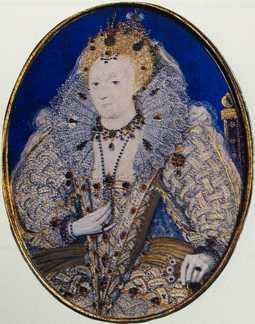Elizabeth's "via media"
Elizabeth's religious policy shaped the future of the Anglican Church as a blend of Roman Catholicism and Genevan Protestantism (Calvinism), a compromise that enabled England to avoid religious wars like those elsewhere in Western Europe.
Since Mary's bishops were unwilling to cooperate, and the Commons was dominated by Protestants, only the Queen's will* prevented a radical Calvinist reform of the Church. The new Acts of Supremacy and Uniformity reestablished England's independence from the Papacy but made broad concessions to Catholics in the liturgy and ritual. Both Catholics and Protestants were dissatisfied, but both were also given hope of later amendments in their favour*.
More Machiavelli?
Dissembling and ambiguity were essential to Elizabeth's policy, especially since religion and government were intertwined, united in the person of the Queen as head* of both Church and State. It is not surprising that English subjects had some confusion as to what their religion really was*. Ambiguous phrasing of important passages in the Book of Common Prayer allowed for different interpretations according to one's faith.
Elizabeth strove to be even-handed in dealing with infringements upon the law by either extreme, whether Puritan or Catholic, but allowed freedom of belief as long as it did not openly flout the law or promote sedition*. It may be that Elizabeth only succeeded in delaying inevitable confrontation by driving extremists underground; her tolerance left problems for her successors that were to be resolved by civil war in the mid-17th century.
Footnotes
-
A difficult position
However, the Queen was supported by moderates in the House of Lords, and some scholars have even argued that her religious compromises were the result of their conservative pressure on a reformist Queen (rather than the opposite: pressure from a conservative Queen on a radical majority).
-
What did Elizabeth believe?
The Queen's personal beliefs have been characterized variously as Puritan, Catholic, Anglican or indifferent. There was sufficient ambiguity that the placement of candles and a cross in her private chapel have been construed by some to indicate Catholic leanings (these were parts of the Catholic ritual and iconography retained by the Anglican Church).
-
What's in a name?
Though Elizabeth altered the wording in the Act of Supremacy to make her "governor" of the Church; this was to placate the bishops who could not bear the thought of a woman as their "head."
-
Theological limbo
Their confusion is amusingly shown by a question put to the Queen by her ambassador to the Holy Roman Emperor in 1567:
As to the question of religion, he wished to be quite clear about it before he left, because, although he was a native-born Englishman and knew as well as others what was passing in the country, he was at a loss to state what was the religion that really was observed here.
-
Tolerance, to a point
Her Majesty, not liking to make windows into men's hearts and secret thoughts, except the abundance of them did overflow into overt express acts and affirmations, tempered her law so as it restraineth only manifest disobedience in impugning and impeaching advisedly and ambitiously her Majesty's supreme power, and maintaining foreign jurisdiction.
(A famous passage on the Queen's policy of respect for individual conscience, by Francis Bacon).
